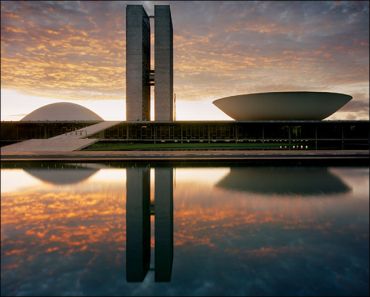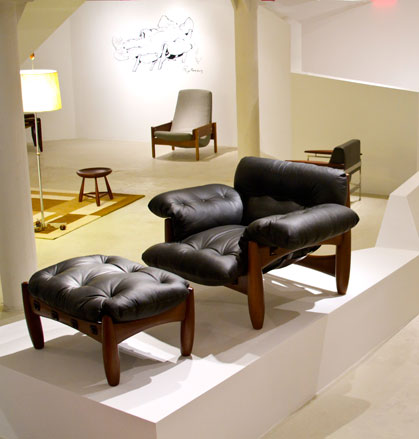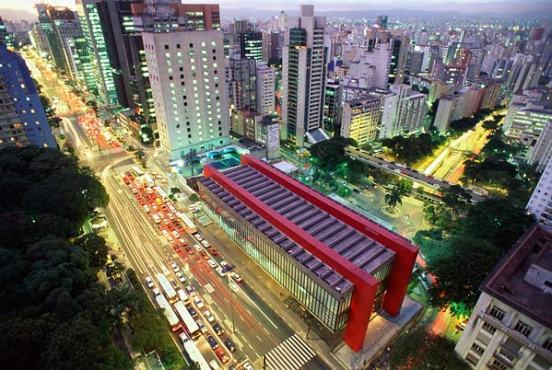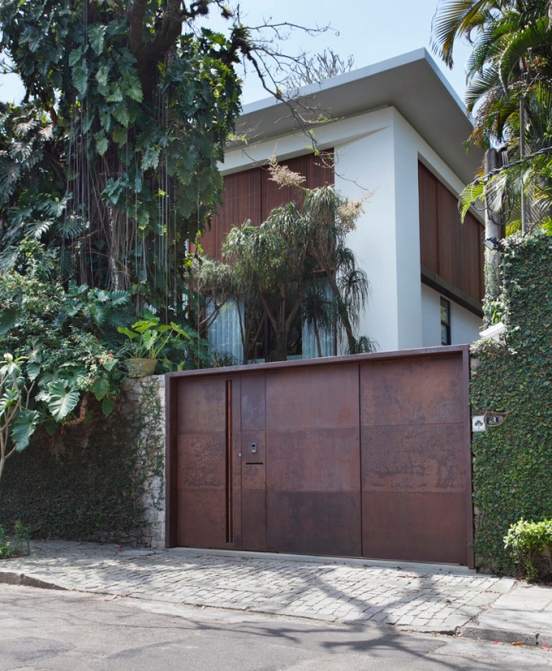Lucas Compan is originally from Sao Paulo, Brazil. He lives and run his own business in New York City – since 2006, when he hit the road heading to Gotham City. Designing brand experiences, crafting stories with design in the greatest city in the world is a great challenge. The secret sauce is the Brazilian creativity mixed with the American entrepreneur spirit. Lucas Compan and 9branding™ are Made Creatively in Brazil™.
São Paulo: South America’s New York City
Sao Paulo is the pulsating heart of Brazil’s economy
 Unique Hotel and Sao Paulo skyline
Unique Hotel and Sao Paulo skyline
Just a 45-minute flight from Rio, Sao Paulo is a fast-paced, cosmopolitan megalopolis and Brazil’s most sophisticated city, cultural center with a lively music and arts scene, mecca of consumption. In Sao Paulo you can find the world’s largest FERRARI reseller – the second one is located in Los Angeles, California; the world’s 4th largest MASERATTI reseller; the world’s 2nd largest PORSCHE reseller, as well as the 2nd LAMBORGHINI reseller. Sao Paulo is the only city in Latin America with ROLLS ROYCE and BENTLEY resellers. Also, in Sao Paulo you can find the world’s largest agricultural planes fleet, the world’s largest private jets fleet – it was NYC until two years ago -, the world’s largest private helicopters fleet, the only city in the world with 4 TIFFANY’s stores, the only city in the world with 4 BULGARI’s stores, the world’s most profitable LOUIS VITTON store, and the most profitable MONT BLANC store outside Switzerland.
Don’t let Sao Paulo’s tarnished image fool you. Rumors of billowing smog, traffic gridlock and rampant crime are patently untrue. This chaotic metropolis has a crime rate that is barely a third of Rio’s, and at 457 years old, it has a history unrivaled in Brazil. During the last decade Sao Paulo has transformed into the pulsating heart of Brazil’s booming economy. Exciting, daunting, and crackling with life 24/7, São Paulo is South America’s New York City. It’s got it all: awesome food, fashion, culture, art and nightlife. Global designer brands compete with hip Brazilian labels, and the posh clubs and restaurants are crammed with people so beautiful, they’d be confined to a magazine cover in any other country. Here you can eat dazzling dishes prepared by celebrity chefs that draw on the city’s international influences at nearly any hour of the day or night. Sao Paulo is constantly evolving, remaking itself as the city of the architectural-landmark hotel. Defined by uber wealth and unparalleled design, hotels hidden within the sprawling, concrete high-rise metropolis like the Unique and the Emilliano offer distinct accommodations with world-class hospitality.
It’s safe to say that the Hotel Unique lives up to its name. 50 Cent, Lady Ga Ga and President Lula da Silva himself are among guests to have slumbered in this bizarre building, which looks like a cross between a giant melon wedge and Noah’s Ark. The acclaimed Brazilian designer Ruy Ohtake claimed that he intended it to look like neither upon its completion five years ago, creating a luxury dwelling both unique in shape and style. The 100m-long by 25m-high inverted arch, with its 95 rooms, has become one of the most distinctive landmarks in Sao Paulo. A model in modern architecture and creativity, Unique’s green copper façade alone makes this hotel live up to its name. Located in the heart of Jardins, the most upscale residential neighborhood in Sao Paulo, and just minutes from Ibirapuera Park, São Paulo’s largest verdant space, the building rises like a behemoth.
Shielding shadowy glass and a desert garden of moon rock, palms and succulents are the first impressions that the hotel offers. Theatrical lofty internal spaces such as the lobby are accentuated and highlighted with walls of marble, and strident, geometric themes make the display even more impressive. A carefully choreographed continuum of circles and squares flow in and out of each other, softened by wooden floors, sleek white furnishings and transparent glass fittings. The design encompasses six floors with over 90 rooms and an additional 10 suites designed by interior designer Joao Armentano. The formation of the large circular windows offers stunning views of Sao Paulo.
The imposing vast reception area is rendered warmer by the complimentary glass of champagne offered at check in. A-list beauties clad in Prada compromise the affable staff. Rooms are compact, yet airy, and almost completely white, with a large porthole window over which a wooden screen would glide at night via remote control from the bedside. Attention has been paid to detail, with both the pine desk and large movable mirror. The bathroom contains a shower with a huge head, and the bath, complete with inflatable pink pillow filled with glowing green feathers (not as tacky as it sounds), also turns into a powerful Jacuzzi.
The bathrooms open into the main room and turndown service includes freshly baked chocolate-chip cookies, and there is a discreet box filled with condoms and chewing gum next to the bed—how convenient.
The best views are from the oblong red-tiled, heated swimming rooftop pool. It buzzes at night with catwalk queens and handsome power brokers, and during the day, a dip here gives you an astonishing 360-degree panorama of the city’s skyscrapers all jutting up through the clouds. Even on a cloudy night, there is a sunset glow, with the terrace artfully illuminated by pink floodlights.
The Skye restaurant located up here is overseen by chef Emmanuel Bassoleil, who has won awards for its innovative menu, which includes a huge sushi and sashimi collection plus interesting Latin fusion twists, such as manioc gnocchi and shrimp in winter squash. It does, however, all come at prices about what you would expect to pay for such quality in London or New York.
 The hotel is also home to the awesome D-Edge nightclub, recently voted one of the worlds best by DJ magazine for its low-attitude, high-party atmosphere and bass blasting sound system.
The hotel is also home to the awesome D-Edge nightclub, recently voted one of the worlds best by DJ magazine for its low-attitude, high-party atmosphere and bass blasting sound system.
Standard rooms start at US$333 per night and go upwards to around $932 a night; all excluding breakfast.
Hotel Unique, Avenida Brigadero Luís Antônio, São Paulo, Brazil (+55 11 3055 4700)
Standing lanky and unadulterated on the poshest street in Sao Paulo, Oscar Freire Street, the 57-room Emiliano hotel, also in the Jardins, is a quiet alternative to the Unique’s brassy vibe. Designed by Brazilian architect Arthur de Mattos Casas, this slick tower’s exterior is all glass and beige tones, topped with a discreet helipad for those who can’t deal with traffic. Diplomats, prime ministers, and Hollywood queens love to duck in and out of this pied-a-tierre. Inside, the modern sophistication is first evident in the airy lobby. Campana brothers’ chairs draped in golden rope surround a ‘living wall’ of plant species from the Brazilian rainforest. A balanced blend of business and vacation travelers will savor the cool, calm ambiance, and the staff is stunning and eager to please. Detail orientation and modern Brazilian sophistication is what best defines the Emiliano Hotel. From the clean lines and muted lighting of the champagne and caviar bar to the Emiliano bar’s hanging orchids and loungy tables, the lower level makes you feel comfy and secure. And quite private.
There are only three rooms on each of the floors. Guest rooms awash in eastern-inspired textures feature huge flat-screen televisions, digital surround sound CD/DVD players, and free high-speed Internet. The setting is relaxing and indulgent: crisp white Egyptian cotton sheets; Brazilian fruit-infused toiletries; an Eames lounge chair upholstered in an earth tones; a wall of amber-colored wood that hide closets and two Sub-Zero drawer refrigerators stocked to the hilt; not to mention a huge bathroom with a startling views. The guest services manager will instruct guests on using the numerous lighting controls (which took a Ph.D. to master), and a personal butler—yes, you get one—offers to unpack bags and help navigate the sci-fi Japanese toilets (that do everything you can imagine and more!). The staff also spoils you with a free bottle of fine wine; succulent indigenous fruit, a heavenly massage (in your room or at the rooftop spa) and the ironing of two items of clothing. All on the house. A favorite indulgence: a pillow selection menu, where you can choose from six pillows of varying firmness.
 The Emiliano Restaurant is quite hidden away from city views. Favored by Brazilian celebs for its sequestered setting, there are only eleven elegant tables, stylishly set with white tablecloths. Tropical music plays delicately in the background. Chef José Barattino favors contemporary Italian cuisine at Emiliano. Born and raised in the Greater São Paulo, the young chef spotlights organic ingredients and actively supports small producers through a partnership with Família , a consortium of sustainable food producing farms in São Paulo State. The veluttata, served with goat cheese semifreddo and black olive breadcrumbs, melts in your mouth and is part of the chef’s four-course tasting menu (R$150, R$300 with wine pairing), which also comes with tagliattelle with prawns, guandu beans and red pepper; duck leg confit with small crusty onions, orange flower honey sauce, yellow manioc baked in a salt crust and fresh spinach; and canolo with Macaé and Ginaduja chocolate, mango and Bali flake salt.
The Emiliano Restaurant is quite hidden away from city views. Favored by Brazilian celebs for its sequestered setting, there are only eleven elegant tables, stylishly set with white tablecloths. Tropical music plays delicately in the background. Chef José Barattino favors contemporary Italian cuisine at Emiliano. Born and raised in the Greater São Paulo, the young chef spotlights organic ingredients and actively supports small producers through a partnership with Família , a consortium of sustainable food producing farms in São Paulo State. The veluttata, served with goat cheese semifreddo and black olive breadcrumbs, melts in your mouth and is part of the chef’s four-course tasting menu (R$150, R$300 with wine pairing), which also comes with tagliattelle with prawns, guandu beans and red pepper; duck leg confit with small crusty onions, orange flower honey sauce, yellow manioc baked in a salt crust and fresh spinach; and canolo with Macaé and Ginaduja chocolate, mango and Bali flake salt.
There may not be a pool in the penthouse, but the spa Casal does have two Japanese hot tubs, a Jacuzzi and sauna with a panoramic view. A stay here is surely going to result in a heavenly and cherished memory – just don’t forget to take your Platinum card. Rue Oscar Freire 384 (+55 11 3068 4399)
EAT
CARLOTA
This Brazilian bistro is the place to be seen for lunch. A revamped 1940s house splashed with audacious, local art and bold Brazilian gastrononym, the menu here lashes together Italian and Brazilian traditions with a generous helping of Argentinian and a dash of Asian. Chef Carla Pernambuco’s multicultural kitchen floats the finest ingredients in her comfort food with atypical results, like her medley of Brazilian snacks such as salt-cod rissois (a turnover), pão de queijo (a hot cheese roll). The succulent sole filet with golden goat’s cheese sauce, fresh palm hearts and mushroom fettuccine is to die for. Another notable dish is grilled lobster tail, manioc purée and Thai vegetable julienne. Save room for the classic Brazilian dessert, Romeo and Juliet, a luscious guava souflé in a queijo catupiry (Brazilian cream cheese) sauce. Rua Sergipe, 753 . Sao Paulo, 01243-001
DALVA A DITO
Impeccable design. Great location. It’s by the same team who opened DOM, one of the snobbiest places to eat in Sao Paulo. Here, Chef Alain Poletto takes city street food and makes it a little more highbrow. It’s a beguiling blend of the simple and subtle. Street snacks that have been reworked, the pasteis (fried snacks) like bolinhos de mandioca and carne seca (fried balls of mandioca and dry meat) are heavenly and probably healthier (and much more pricey) than the ones you find on every corner. Moqueca is a behemoth of a fish stew in a thick stone pot, brought to your table and then filled with heavy fishy broth. And the rotisserie chicken literally melts in your mouth—and it should, for R$65! For dessert, try chocolate fused with a rare Amazonian herb priprioca, a woody, spicy tone usually used in perfumes. Rua Padre João Manuel, 1115 – Cerqueira César . Sao Paulo, 01411-001
MARIA BRIGADEIRO
Brigadeiro is a dessert that only exists in Brazil. It’s a national institution, like soccer, samba and caipirinhas. Small, round and sweet, these decadent balls of chocolate explode in your mouth. Sweet, creamy and sticky, this ball of chocolate looks like a truffle. Since she was six years old, chocolatier Maria Brigadeiro has sold her collection of delectable handmade chocolates in this sumptuously elegant shop. Watch the portly ladies roll them through the pink accented display cases like those found in jewelry shops. Marvel at the trays of chocolate gems beautifully molded into balls of perfection. You can choose everything from orange blossom to rose water and dried plums. Favorite choice: pistachio and cacao! Delicious beyond belief. Rua Capote Valente 68
Pinheiros
São Paulo | Orders: +55-11-3085-3687
Cool without trying to be cool
Brazilian architecture | Itiquira House – Rio de Janeiro
Relaxing and breathing deeply. It may not come as a surprise to anyone that this would be our reaction this exquisitely refurbished residence, located in one of Rio de Janeiro’s most exclusive neighborhood
It has so many of the features we love. The structure seems to belong to the site. The indoor spaces connect with the outdoors, and the subtle surface textures and materials showcase the art and the mid-century modernist vibe of the furnishings.
There is visual room to breathe, to see. There’s space to enjoy the art, distance to appreciate the gardens
It lacks all of the typical design-magazine photo-session set-ups; the painfully over-staged vignettes, the overly sterile designer look. There is no ego or bravado, just ease and style. This is cool without trying to be cool; dramatic without all the drama.
This is that confident, mature style that is so difficult to achieve and impossible to fake.
The white, colonial-style house has good bones to start with: unobtrusive scale and proportions, spectacular site with access to views, natural building materials.
It is also surrounded by sublime mature gardens originally designed by the late Roberto Burle Marx, the designer of the Copacabana Beach Promenade with its distinctive, black-and-white Portuguese geometric wave pattern.
But the already great structure of this house was improved by a recent, complete overhaul by Brazilian architect Gisele Taranto.
The 1,500 square-meter (about 16145 square feet) house consists of two blocks. The larger block is the main family residence, the smaller one accommodates staff rooms, laundry, garage, home theater and the spa that is directly connected with the outside pool and patio area.
Taranto retained this division of functions, but rearranged most of the rooms and built two additional spaces on top of the existing ones: a home office with a roof-top garden on top of the residence, and an additional two-bedroom apartment for staff on top of the other block.
To provide better access to the outside, new, much larger windows and sliding glass doors were created. Wooden exterior slat screens and a wide canopy all around the house were built to provide protection from the extreme sunlight and heavy rains of the area.
Brazilian architect Oscar Niemeyer inspires New H.Stern jewelry collection
Oscar Niemeyer, 103, is Brazil’s most famous architect. Considered one of the most influential names in international modern architecture, he is responsible for the project of Brasilia, the country’s capital constructed in the late 50’s, and many other iconic buildings including UN’s headquarters in New York, a collaboration with French master Le Corbusier.

Curves have been his passion over the course of a lifetime. They define the architect’s own style: the lightness of the curved forms that create spaces full of harmony, grace and elegance.
The H.Stern by Oscar Niemeyer Collection is the initiative of Roberto Stern, president and creative director of H.Stern, who has always given special emphasis to organic and sinuous forms in jewelry.
“We do not find straight lines in nature, therefore I like asymmetry and irregular contours, which are more human and natural,” said Stern. It was this shared passion with the architect that led Stern to launch the collection.
For the first time, Niemeyer personally approved a collection of jewelry created in his honor, and based on his own sketches, his curved lines. Several of the designs include pieces inspired by the female form.
“The jewels are extremely pretty and very light. It’s incredible how they have managed to exactly replicate my designs,” the architect said. “The people who made these jewels are very talented!”
The jewelry designers sought inspiration not in the final form of Niemeyer’s revered creations, already widespread, but in their primary element: the apparently unpretentious outlines and contours which are transformed into architectural works like those in Brasília; Pampulha, an architectural project in Minas Gerais state; the Copan building, in São Paulo; and the surprising Museum of Contemporary Art in Niterói, considered one of his finest works.

Niemeyer appears to bend straight lines in his concrete structures, transforming curves into a natural solution for his creations. H.Stern does the same with gold and diamonds. Besides the curving contours, empty spaces—so prized by the architect in his concrete sculptures—are also reflected in the jewelry. Rings, bracelets and earrings emphasize simple lines, interspersed with empty spaces.
The H.Stern Collection by Oscar Niemeyer includes jewelry in gold and diamonds, composed of six different lines and named for some of his works and famous projects. They convey the simplicity of the outlines, which are captured in a few, essential lines: loose, free and flowing.
Below are the six lines that make up the collection:

Copan bracelet, in yellow gold

Copan building, in downtown Sao Paulo, Brazil
Copan—One of the icons of the famous concrete poetry of the capital São Paulo, the Copan building has hovered like a wave on the horizon of the metropolis since the 1950s, contrasting with the straight angles that predominate in the local architecture. It was the wavy, striking design that was the inspiration behind the Copan jewelry collection, with rings in wavy forms and a voluminous yellow gold bracelet.
Brasília—The architecture of the city of Brasilia, glimpsed in the sketches submitted by Lucio Costa for the international design contest for the new capital of Brazil, was the result of Oscar Niemeyer’s definitive influence. The concave and convex domes of the National Congress and the columns of the Alvorada and Planalto Palaces and the Supreme Court are highly original features. Combining these with the spectacular forms of the columns of the Cathedral and the palaces of Itamaraty and Justica, Niemeyer succeeded in closing the rectangular and symmetrical perspective formed by the repetition of the Esplanada and Ministry buildings.
The concave and convex domes that epitomize the building of the National Congress gave form to an yellow gold bracelet, in which continuous lines and empty spaces encircle the female wrist in a light, sensual way. The jewel reconstructs Niemeyer’s proposal when he planned, in 1958, what was to become one of the most beautiful scenes of the federal capital and one of his 35 works to be listed by the Historical Heritage of the country. Besides the bracelet, there are also earrings in which opposite curves join at the tips, with singular lightness.
Pampulha—The inspiration for this line comes from the sinuous design of the roof of the São Francisco de Assis church in Pampulha, state of Minas Gerais, Brazil. The project was created by Niemeyer in the 1940s, at the request of Juscelino Kubitschek, then mayor of the city who would later become President of Brazil. The structure was highly controversial due to its bold forms. Niemeyer said, “I covered it with curves, all kinds of curves, as a statement against the architecture characterized by straight lines that predominated up until then.”
The wavy design of this emblematic work was reproduced by H.Stern in rings, earrings and bracelets in white gold and diamonds.

PAMPULHA bracelet in white and diamonds

Pampulha Church, in Belo Horizonte, Brazil
Sketch—Amid the iconic designs of the Pampulha and the National Congress of Brasília, the wall of Niemeyer’s office displays an intriguing design. Two curved, perpendicular lines appear to form the sketch for one of the consistently bold columns of his buildings. Who has seen the arched columns of the Cathedral of Brasília or the Palácio do Planalto? Or, perhaps, the profile of one of the dish-like domes which he transforms into functional buildings. Or it may be an unpretentious drawing that has not been transformed into works of concrete.
 Sketch earrings in yellow gold
Sketch earrings in yellow gold
 National Congress buildings, in Brasília, the capital city of Brazil
National Congress buildings, in Brasília, the capital city of Brazil
This sketch of extreme simplicity was interpreted by H.Stern in a pair of earrings—in white gold and diamonds—in which the metal line folds between the frontal part and behind the earlobe.
Curves—“If the straight line is the shortest route between two points, the curve is what makes concrete search for the infinite,” said Niemeyer, explaining his preference for fluid, sinuous lines. Curves baptize this line of jewelry with rings and earrings. In the earrings, the strands form wavy layers, one on top of the other. The design explores one of the principle elements of architecture: perspective. The visual impression given differs depending from which the jewelry is viewed.

CURVES Ring in white gold and diamonds
Flower—Niemeyer’s work also includes sketches of singular beauty, like one of a hand holding a flower with four leaves. A single line of form and image, reminiscent of a child’s drawings in its simplicity. This drawing provided the inspiration for pendants and bracelet in yellow gold which represent the flower, closely following the spontaneous vision of the architect and designer.
The gold flowers are hollow, in reference to Niemeyer’s appreciation for unfilled areas. “Architecture is about overcoming spaces… I cannot understand those who are afraid of open spaces. Space is part of architecture.” It is also part of the jewelry.
Brazilian musicians Carlinhos Brown and George Israel have also composed a song to honor the launch of the H.Stern by Oscar Niemeyer Collection. “Linhameyer” (a blending of Niemeyer’s name with the word Linha—“line” in Portuguese) speaks of the sinuous lines in the architect’s drawings.

H. STERN
645 Fifth Avenue at 52nd Street
New York, New York 10022
212-688-0300
800-747-8376
www.hstern.net
Brazilian designer Sergio Rodrigues shop-in-shop at Espasso, New York

Pictured here is the ‘Vronka’ armchair, 1962

A new line of Rodrigues re-editions previously only available in Brazil are now also on offer at Espasso. The Poltorna Mole, 1957, seen here in the foreground, frames the Luminária Sérgio Augusto, 1965; Banco Mocho, 1954; Poltrona Vronka, 1962; and Poltrona Beto, 1958
[ See more at Wallpaper Magazine / November 2011 ]
Espasso New York
Specialized in modern and contemporary Brazilian furniture

38 N. Moore Street
New York, NY 10013
Phone | 212.219.0017
Hours | Mon – Fri: 10am – 6pm . Sat: 12 – 6pm . Sun: closed
The Giant Is No Longer Asleep
In new spot, giant arises from scenic Sugar Loaf Mountain
After years of hearing Brazil referred to as a sleeping giant, Diageo’s Johnnie Walker is appealing to the fast-growing market with a blockbuster spot recognizing Brazil as a colossus that has finally awakened. In “Rock Giant,” the colossus emerges from Rio de Janeiro’s scenic Sugar Loaf mountain landmark.
“We lived with the image of having a lot of potential but not really taking advantage of all the wonderful resources we had,” said Alexandre Gama, president and chief creative officer of Neogama/BBH, the Sao Paulo office of Johnnie Walker’s global agency Bartle Bogle Hegarty. “[People used to say] Brazil is the country of the future, and always will be. We don’t accept that any more.”
In the spot, which broke Friday evening on Facebookand on Brazilian TV on Sunday, the earth cracks and boulders fly as Rio residents watch a giant arise from the famous rock formation. He carefully sets down the cable car that runs along Sugar Loaf Mountain and stands tall. As he takes his first steps, the words “The giant is no longer asleep” appear in Portuguese, before the campaign’s familiar “Keep Walking” global tagline, tweaked to read “Keep Walking, Brazil.”

Mr. Gama said the campaign came about after David Gates, global category director for Diageo’s whiskey brands, visited Brazil early last year and wanted to meet Mr. Gama. During their meeting in the hotel lobby, Mr. Gates, who was previously Diageo Asia’s marketing director, said he felt the kind of momentum was happening in Brazil that he had witnessed earlier in China. He said that opened the possibility to create a campaign that would tap into this change in a very Brazilian way. Diageo is also experiencing Brazil’s momentum first hand, as Johnnie Walker’s fastest-growing market with a 30% annual increase in sales volume.
On his way to Rio’s downtown airport one day to catch the shuttle back to Sao Paulo after a client meeting, Mr. Gama glimpsed Sugar Loaf Mountain, and the idea was born. He said it was important that the message about the sleeping giant awakening was delivered by a non-Brazilian entity like an international brand, so the tagline “Keep Walking, Brazil” spelled the country’s name with a ‘z’ rather than using the Portuguese spelling, Brasil.
Mr. Gama said the spot had more than 187,000 views on YouTube by Sunday night. He helped the spot go viral by sending it to his friend Luciano Huck, a popular Brazilian TV host who has more than three million Twitter followers and tweeted about the spot. The agency also bought a full-page ad in the form of a false cover run by one of Sao Paulo’s leading daily newspapers, Folha de Sao Paulo, with “Sugar Loaf Mountain was part of a giant” as the lead story.
The complex production employed 420 people.
“The challenge was how to make someone covered by birds, trees and rocks look powerful,” he said. “That was the biggest problem.”
The spot, directed by Gorgeous with post-production and composition of the giant by The Mill, required special software to be written enabling the trees to react to the movements of a giant more than a mile high. [ Source : AdAge ]

Jose Padilha on the ‘Robocop’ Remake and ‘Elite Squad 2
The hot “new” director talks about his take on Robocop, its social commentary and the future of the Brazilian film industry

Brazilian director Jose Padilha’s smash sequel Elite Squad: The Enemy Within played at Fantastic Fest. The cop drama expands on Padilha’s themes of corruption in Rio. Padilha’s coming to Hollywood to direct another cop movie, the remake of Robocop. Elite Squad: The Enemy Within opens November 11 in New York and November 18 in Los Angeles for a platform release, and Padilha is already prepping Robocop.

Jose Padilha: I’ve done three movies about violence in Rio. I’ve done a documentary called Bus 174 which is about a street kid that hijacks a bus in Rio. I don’t know if you’ve seen that. Then I’ve done the first Elite Squad and now this is the third movie I do about sort of the same subject matter, that’s related to corruption. So I guess I am an old timer filmmaker that deals with corruption.
But I mean is it relatively new for the Brazilian film industry to address it?
Brazil has a peculiar kind of history in filmmaking because we were a dictatorship. That means we were run by generals until the ‘80s. It was a right wing dictatorship so most filmmakers, if not all, were Marxists in the same way where people who were controlled by the left wing dictatorship in Czechoslovakia were capitalists. You always oppose the regime. So filmmaking in Brazil was made from a Marxist perspective. It was full of metaphors to avoid censorship. We had censorship. We had to send our movies to generals, they would look at it and they would cut stuff out of the film. So everything was very difficult for regular people to grasp. It was all sort of like an inside joke between filmmakers that understood some sort of metaphor that would get through the censorship. But Brazilian movies are changing now. Because there’s no more censorship, we don’t have a dictatorship, we can vote so we’ve been able to say things directly. I think this started in a big way with City of God, which is a social commentary on violence by drug dealers and it’s not metaphorical at all. It’s a film that you go, it has action and so on. Myself and other filmmakers now are doing movies like this so I would say it started like 10 years ago. So you’re right, there’s a difference in Brazilian filmmaking now.
What is your philosophy on shooting action?
Well, most people don’t realize a lot of the way you shoot action is defined by the schedule. You can’t miss a day because it’s very expensive. There are a lot of things that have to do with the budget and my movies don’t have an American budget. They have a small budget so I have to do things fast. My philosophy is to go for it, to try to get the risky shots, to try to get the shot that you may not get in one day because it’s worth it. So I like my connecting shots, which is let’s say I’m shooting a scene of a helicopter with the protagonist overseeing the invasion of his land. I want to have the same shots, the face of the guy inside the helicopter, he’s looking down at something, and the camera goes and sees just the moment where a bomb explodes in his lap. In order to get that shot, you have to time the camera, the helicopter, the camera has to go to the right place, the explosion has to set off. It’s hard. It’s much easier to shoot in separation. You have the face, you’ve got the helicopter. I try to go for the connecting shot because I think it brings action to life. It also gives you a better sense of geography which I think is important in action scenes. So that’s my philosophy. Go for the connecting shot and run the risk of not making it through the day. Read more…

A Hip Street in Sao Paulo
Clubs with live music have woken up Rua Augusta, where rich and poor mingle and party into the morning hours. But you probably won’t find samba here.

Teenagers in black jeans and hoodies sit sipping vodka on the sidewalk. At a venue down a few blocks of graffiti-covered walls, a man in a shark costume belts out rock songs. Outside a dance club, well-paid fashion designers mingle with street punks and transvestite prostitutes.
It’s far from the tropical sun, sex and samba image of Brazil that looms large in the mind of tourists.
Rapid change is gripping Brazil, especially Sao Paulo, the largest city in South America and the most expensive in the Western Hemisphere. A red-hot economy fueled by commodities trade with China and decades of stable government have made many Brazilians more prosperous. New youth movements have sprung from Sao Paulo’s gritty urban mix. Read more … [ Source : Los Angeles Times ]
Top 10 Football Ads of All Time

Although football can get extremely serious, with manager-bashing and player-insulting, we often forget why we all follow the sport in the first place: passion for the game, and joy at watching our clubs play.
So, in the midst of a very active, gossipy, rumour-filled 2011 summer transfer window, times call for an article like this one.
Nothing brings happiness back to football like a clever advert, whether it’s promoting the World Cup or just a new pair of Nike boots. The best adverts just make all football fanatics smile.
So, without further ado, here are the top 10 football adverts of all time.



















